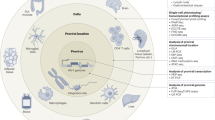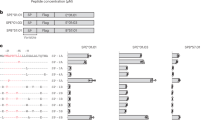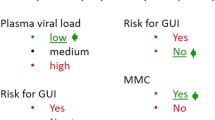Abstract
Major histocompatibility complex (MHC) genes (HLA in humans) regulate the immune response to foreign antigens. Molecular and serologic techniques were used to identify products of HLA class I, class II and transporter (TAP) genes (also part of the MHC) in homosexual seroconverters to human immunodeficiency virus type 1 (HIV–1). Comprehensive statistical analysis produced an HLA profile that predicted time from HIV–1 infection to the onset of AIDS. The profile was developed in a cohort of 139 men and evaluated in a second unrelated cohort of 102 men. In the evaluation cohort, the profile discriminated a sixfold difference between groups with the shortest and longest times to AIDS (P = 0.001). These findings support current theory about control of antigen processing by HLA genes and have implications for immunopathogenesis of HIV–1 and other infections.
This is a preview of subscription content, access via your institution
Access options
Subscribe to this journal
Receive 12 print issues and online access
$209.00 per year
only $17.42 per issue
Buy this article
- Purchase on Springer Link
- Instant access to full article PDF
Prices may be subject to local taxes which are calculated during checkout
Similar content being viewed by others
References
Schrager, L.K., Young, J.M., Fowler, M.G., Mathieson, B.J. & Vermund, S.H. Long-term survivors of HIV infection. Acquir. Immune Defic. Syndr. 8 (suppl. 1), S95–S108 (1994).
Phair, J. et al. Acquired immune deficiency syndrome occurring within 5 years of infection with human immunodeficiency virus type-1: The Multicenter AIDS Cohort Study. J. Acquir. Immune. Defic. Syndr. 5, 490–496 (1992).
Keet, I.P.M. et al. Characteristics of long-term asymptomatic human immunodeficiency virus type 1 in men with normal and low CD4+ cell counts. J. Infect. Dis. 169, 1236–1243 (1994).
Munoz, A. et al. Long term survivors with HIV-1 infection: Incubation period and longitudinal patterns of CD4+ lymphocytes. Acquir. Immune. Defic. Syndr. Hum. Retrovirol. 8, 496–505 (1995).
Hessol, N.A. et al. Progression of human immunodeficiency virus type 1 (HIV-1) infection among homosexual men in hepatitis B vaccine trial cohorts in Amsterdam, New York City, and San Francisco, 1978–1991. Am. J. Epidemiol. 139, 1077–1087 (1994).
Alcabes, P., Munoz, A., Vlahov, D. & Friedland, G.H. Incubation period of human immunodeficiency virus. Epidemiol. Rev. 15, 303–318 (1993).
Rosenberg, P.S., Goedert, J.J. & Biggar, R.J. Effect of age at seroconversion on the natural AIDS incubation distribution: Multicenter hemophilia cohort study and the international registry of seroconverters. Acquir. Immune. Defic. Syndr. 8, 803–810 (1994).
Ashton, L.J., Learmont, J., Luo, K., Wylie, B. & Stewart, G. HIV infections in recipients of blood products from donors with known duration of infection. Lancet 344, 718–720 (1994).
Rezza, G. et al. in HIV Epidemiology: Models and Methods. (ed. Nicolosi, A.) 279–291 (Raven, New York, 1994).
Centers for Disease Control, Revision of the CDC surveillance case definition for acquired immunodeficiency syndrome. Morbid. Mortal. Weekly Rep. 36 (1S) 3S–15S (1987).
Townsend, A. et al. Assembly of MHC class I molecules analyzed in vitro. Cell 62, 285–295 (1990).
Schumacher, T.N.M. et al. Peptide selection by MHC class-I molecules. Cell 62, 563–567 (1990).
Kelly, A. et al. Assembly and function of the two ABC transporter proteins encoded in the human major histocompatibility complex. Nature 355, 641–644 (1992).
Spies, T. et al. Presentation of viral antigen by MHC class I molecules is dependent on a putative peptide transporter heterodimer. Nature 355, 644–646 (1992).
Klein, M.R. et al. Kinetics of gag-specific cytotoxic T lymphocyte responses during the clinical course of HIV-1 infection: A longitudinal analysis of rapid progressors and long-term asymptomatics. J. Exp. Med. 181, 1365–1372 (1995).
Rowland-Jones, S. et al. HIV-specific cytotoxic T-cells in HIV-exposed but uninfected Gambian women. Nature Med. 1, 59–64 (1995).
Becker, Y. HIV-1 proteins in infected cells determine the presentation of viral peptides by HLA class I and class II molecules and the nature of the cellular and humoral antiviral immune responses. Virus Genes 8, 249–270 (1994).
Doherty, P.C. & Zinkernagel, R.M. A biological role for the major histocompatibility antigens. Lancet 1, 1406–1409 (1975).
Dupont, B. (ed.) Immunobiology of HLA. (Springer, New York, 1989).
Tiwari, J. & Terasaki, P. (eds.) HLA and Disease Associations. 383–400 (Springer, New York, 1985).
Hill, A.V.S. et al. Common West African HLA antigens are associated with protection from severe malaria. Nature 352, 595–600 (1991).
Kroner, B.L., Goedert, J.J., Carrington, M., Mann, D.L. & Blattner, W.A. Concordance of haplotype sharing, CD4 decline and AIDS in hemophilic sibling pairs. Acquir. Immune Defic. Syndr. 9, 275–280 (1995).
Keet, I.P.M., Klein, M.R., Just, J.J. & Kaslow, R.A. The role of host genetics in the natural history of HIV-1 infection: The needles in the haystack. Acquir. Immun. Defic. Syndr. Hum. Retrovir. (in the press).
Mann, D.L., Carrington, M.N. & Kroner, B.L. The human major histocompatibility complex in HIV-1 pathogenesis. Acquir. Immune Defic. Syndr. 8 (suppl. 1), S53–S60 (1994).
Kaslow, R.A. & Mann, D. The role of the major histocompatibility complex in human immunodeficiency virus infection — ever more complex?. J. Infect. Dis. 169, 1332–1333 (1994).
Fukuda, K. et al. Statistical detection of HLA and disease association. Tissue Antigens 26, 81–86 (1985).
Klitz, W., Thomson, G., Borot, N. & Cambon-Thomsen, A. in Evolutionary Biology, Volume 26. (ed. Hecht, M.K.) 35–72 (Plenum, New York, 1992).
Thursz, M.R. et al. Association between an MHC class II allele and clearance of hepatitis B virus in the Gambia. N. Engl. J. Med. 332, 1065–1069 (1995).
Phillips, R.E. et al. Human immunodeficiency virus genetic variation that can escape cytotoxic T-cell recognition. Nature 354, 453–459 (1991).
Kubo, R.T. et al. Definition of specific peptide motifs for four major HLA-A alleles. J. Immunol. 152, 3913–3924 (1994).
Fukazawa, T. et al. Testing the importance of each residue in a HLA-B27-binding peptide using monoclonal antibodies. J. Immunol. 152, 1190–1196 (1994).
Goedert, J.J. et al. Decreased helper T lymphocytes in homosexual men. I. Sexual contact in high incidence areas for the acquired immunodeficiency syndrome. Am. J. Epidemiol. 121, 629–636 (1985).
Kaslow, R.A. et al. The Multicenter AIDS Cohort Study: Rationale, organization and selected characteristics of the participants. Am. J. Epidemiol. 126, 310–318 (1987).
Amos, D.B., Pool, P. & Grier, J. in Manual of Clinical Immunology. (eds. Rose, N. & Friedman, H.) 978–986 (American Society for Microbiology, Washington, 1980).
Erlich, H.A. & Bugawan, T.L. in PCR Technology: Principles and applications for DNA Amplification. (ed. Erlich, H.A.) 193–208 (Stockton, New York, 1989).
Carrington, M. et al. Typing of HLA-DQA1 and DQB1 using DNA single-strand conformation polymorphism. Hum. Immunol. 33, 208–212 (1992).
Bannai, M. et al. Discrimination of human HLA-DRB1 alleles by PCR-SSCP (single-strand conformation polymorphism) method. Eur. J. Immunogenetics 21, 1–9 (1994).
Carrington, M., Colonna, M., Spies, T., Stephens, J.C. & Mann, D.L. Haplotypic variation of the transporter associated with antigen processing (TAP) genes and their extension of HLA class II region haplotypes. Immunogenetics 37, 266–273 (1993).
PHREG, SAS Release 6.09, SAS Institute, Inc., Gary, North Carolina.
Munoz, A. & Townsend, T.R. in Prevention and Control of Nosocomial Infection. 2nd edn. (ed. Wenzel, R.) (Williams and Wilkins, Baltimore, Maryland, 1993).
Miller, R.G. Survival Analysis. (Wiley, New York, 1981).
Begovich, A. et al. Polymorphism, recognition and linkage disequilibrium within the HLA class II region. J. Immunol. 148, 249–258 (1992).
Carrington, M. et al. Major histocompatibility complex class II haplotypes and linkage disequilibrium values observed in the CEPH families. Hum. Immunol. 41, 234–240 (1994).
Author information
Authors and Affiliations
Rights and permissions
About this article
Cite this article
Kaslow, R., Carrington, M., Apple, R. et al. Influence of combinations of human major histocompatibility complex genes on the course of HIV–1 infection. Nat Med 2, 405–411 (1996). https://doi.org/10.1038/nm0496-405
Received:
Accepted:
Issue Date:
DOI: https://doi.org/10.1038/nm0496-405
This article is cited by
-
Innate receptors modulating adaptive T cell responses: KIR-HLA interactions and T cell-mediated control of chronic viral infections
Immunogenetics (2023)
-
A large population sample of African HIV genomes from the 1980s reveals a reduction in subtype D over time associated with propensity for CXCR4 tropism
Retrovirology (2022)
-
Immunoglobulin-like receptors and the generation of innate immune memory
Immunogenetics (2022)
-
Administration of broadly neutralizing anti-HIV-1 antibodies at ART initiation maintains long-term CD8+ T cell immunity
Nature Communications (2022)
-
HIV-1 and human genetic variation
Nature Reviews Genetics (2021)



